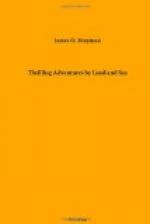[Illustration]
On this discovery being made, the countenances of the savages grew dark and lowering. He saw at once that his fate was to be decided on the principles of Indian vengeance, and, being bound, had but little hope of escape. He, however, put on the appearance of as much unconcern as possible. The Indians withdrew by themselves to decide in what manner they should despatch their unhappy victim. They soon returned, their visages covered with a demoniac expression. A few went to gathering wood; another selected a spot, and soon a fire was kindled. Van Campen looked upon these preparations, which were being made to burn him alive, with feelings wrought up to the highest pitch of agony; yet he, with much effort, appeared calm and collected. At last, when the preparations were completed, two Indians approached, and began to unloose the cords with which he was bound. To this he submitted. But the moment he was fully loosed, he dashed the two Indians aside—felling one upon the earth with a blow of his fist—and darted off toward the fort, where he hoped to receive protection from the British officers. Tomahawks gleamed in the air behind him—rifle balls whistled around—but onward still he flew. One unarmed Indian stood in his path and intercepted him. With a giant spring, he struck him in the breast with his feet, and bore him to the earth. Recovering himself, he again started for the woods, and, as he was running for life—with the fire and faggot behind him, and a lingering death of torture—he soon outstripped all his pursuers. It being near night, he effected his escape, arrived at the fort, and was sent down the river to Montreal, to be out of the way of the savage Senecas, who thirsted for his blood as a recompense for that of their brethren whom he had slain.
FIRE IN THE FOREST.
“The summer of 1825 was unusually warm in both hemispheres, particularly in America, where its effects were fatally visible in the prevalence of epidemical disorders. During July and August, extensive fires raged in different parts of Nova Scotia, especially in the eastern division of the peninsular. The protracted drought of the summer, acting upon the aridity of the forests, had rendered them more than naturally combustible; and this, facilitating both the dispersion and the progress of the fires that appeared in the early part of the season, produced an unusual warmth. On the 6th of October, the fire was evidently approaching New Castle; at different intervals fitful blazes and flashes were observed to issue from different parts of the woods, particularly up the northwest, at the rear of New Castle, in the vicinity of Douglasstown and Moorfields, and along the banks of the Bartibog. Many persons heard the crackling of falling trees and shriveled branches, while a hoarse rumbling noise, not dissimilar to the roaring of distant thunder, and divided by pauses, like the intermittent discharges of artillery, was distinct and audible. On the 7th of October, the heat increased to such a degree, and became so very oppressive, that many complained of its enervating effects. About twelve o’clock, a pale, sickly mist, lightly tinged with purple, emerged from the forest and settled over it.




